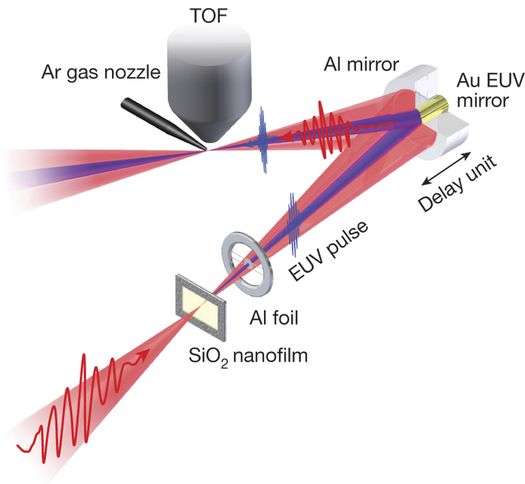October 20, 2016 report
Researchers demonstrate extension of electronic metrology to the multi-petahertz frequency range

(Phys.org)—A team of researchers with the Max-Planck-Institut für Quantenoptik has found a way to link previously demonstrated laser light-induced high-speed switching of an insulator between conducting states and high-frequency light emissions from insulators blasted with laser pulses. In their paper published in the journal Nature, the team describes the techniques they used to pull off this feat. Michael Chini with the University of Central Florida offers a News & Views piece on the work done by the team in the same journal issue, and explains what hurdles still need to be overcome before devices making use of the technology can be developed.
As Chini notes, huge strides have been made over the past few decades in using light to convey information, while at the same time, electronic devices have continued to be limited by the upper frequency limits at which electric currents can be driven. As he also notes, prior research has shown that it is possible to use light in the form of laser pulses to drive electrons through a bulk insulator at much higher than normal frequencies, but until now, there was no way to measure the oscillations of those electrons, a necessary part of applying them in a high-speed device.
In this new effort, the researchers took advantage of the fact that when electrons speed up, they emit what are known as high-order harmonics, which just happen to be a direct reflection of the motion of those electrons. They used an attosecond streak camera to measure these harmonics in a silica nanofilm and noted that the light was emitted in bursts lasting less than 500 attoseconds. These findings suggest that it should be possible to build devices that use lasers to push the oscillating frequency of electrons up to 100 times that of devices currently used to test the limit (into the multi-petahertz range). Currently, Chini notes, more work still needs to be done—subtle variations that occur in the process will have to be removed, for example, and testing will have to be done to see if the same results can be obtained with materials other than silica. Also, it is still not clear if the laser-pulsed approach causes any negative impact on current production.
More information: M. Garg et al. Multi-petahertz electronic metrology, Nature (2016). DOI: 10.1038/nature19821 , www.nature.com/nature/journal/ … ull/nature19821.html
Abstract
The frequency of electric currents associated with charge carriers moving in the electronic bands of solids determines the speed limit of electronics and thereby that of information and signal processing1. The use of light fields to drive electrons promises access to vastly higher frequencies than conventionally used, as electric currents can be induced and manipulated on timescales faster than that of the quantum dephasing of charge carriers in solids2. This forms the basis of terahertz (1012 hertz) electronics in artificial superlattices2, and has enabled light-based switches3, 4, 5 and sampling of currents extending in frequency up to a few hundred terahertz. Here we demonstrate the extension of electronic metrology to the multi-petahertz (1015 hertz) frequency range. We use single-cycle intense optical fields (about one volt per ångström) to drive electron motion in the bulk of silicon dioxide, and then probe its dynamics by using attosecond (10−18 seconds) streaking6, 7 to map the time structure of emerging isolated attosecond extreme ultraviolet transients and their optical driver. The data establish a firm link between the emission of the extreme ultraviolet radiation and the light-induced intraband, phase-coherent electric currents that extend in frequency up to about eight petahertz, and enable access to the dynamic nonlinear conductivity of silicon dioxide. Direct probing, confinement and control of the waveform of intraband currents inside solids on attosecond timescales establish a method of realizing multi-petahertz coherent electronics. We expect this technique to enable new ways of exploring the interplay between electron dynamics and the structure of condensed matter on the atomic scale.
Michael Chini. Optical physics: Speedy electrons exposed in a flash, Nature (2016). DOI: 10.1038/538325a
Journal information: Nature
© 2016 Phys.org





















